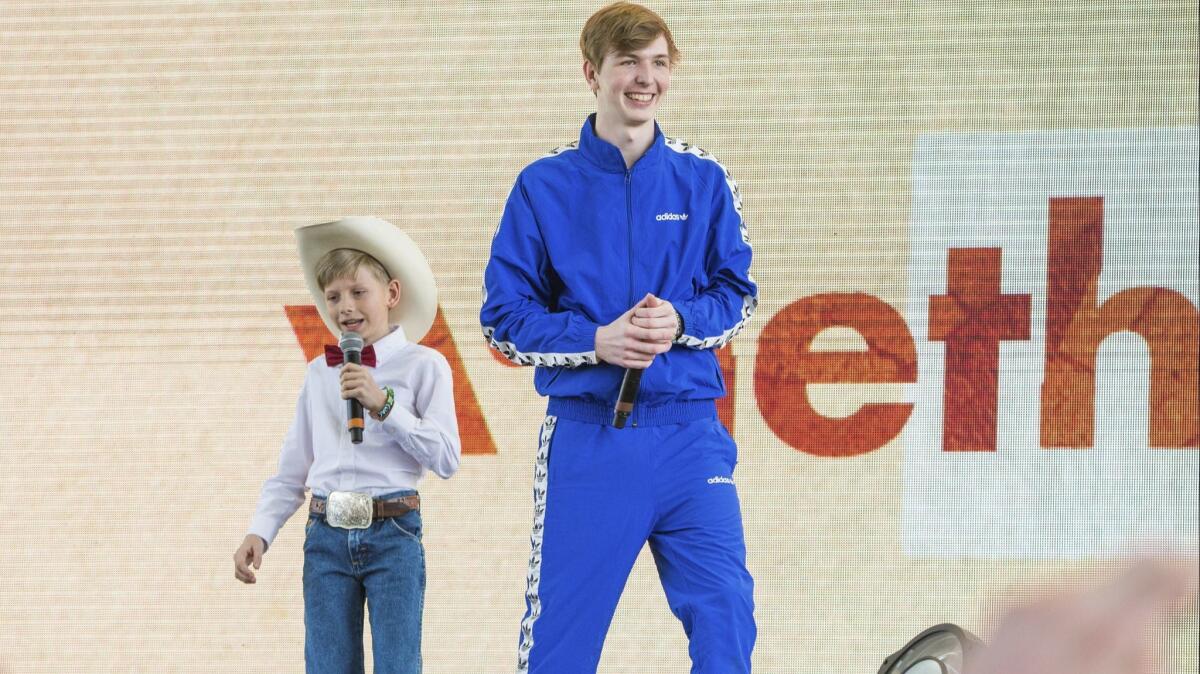Coachella’s viral yodeling boy moment is just the start of the festival’s latest makeover

The Sahara Tent provided the clearest definition of what the Coachella Valley Music and Arts Festival has become when 11-year-old Mason Ramsey took the stage Friday afternoon alongside electronic dance artist Whethan.
Two weeks ago the preteen from Golconda, Ill., was unknown, and then a video of him yodeling in a Walmart went viral and he became the next overnight sensation — with his own hashtags: #WalmartYodelBoy and #WalmartYodelingKid.
With few events as trendy as Coachella — just check your Instagram and Twitter feeds — it was no surprise Ramsey’s arrival was met with rapturous applause and not with the nod of irony one might expect.
“Everybody took your picture, right?” Whethan asked after the kid nervously pushed through a performance of the Hank Williams Sr. classic that made him a “celebrity.”
It was a moment that aptly distilled the culture of the festival as a can’t-miss destination for music fans — and those who just want to be seen.
For as big and loud of a presence that Coachella is, the three-day blowout is ultimately about escapism (with a heavy heaping of surprises primed for social media posting).
Whether you’re a spoiled Hollywood executive or part of the overworked and overstressed 99%, Coachella exists as an opulent escape from our day to day.
It’s an experience that’s become incredibly coveted given its bill and place among the millennial zeitgeist, and this year is bigger than ever as guests were greeted with a refreshed layout that not only alleviated the ingress between stages but also made the festival feel immediately more immersive.
The Sahara tent was relocated inward toward the experimental Do Lab, making the popular dance mecca a straight shot to the main stage.
Sahara’s move allowed for a welcomed remix of the traditional Coachella footprint.
Shifting all of the secondary stages made room for a far more comfortable traverse across the polo fields.
Catching sets at the Outdoor Theater now felt more akin to an amphitheater instead of the stage feeling overpowered by the main stage and the smaller Yuma tent now had a perch that made it feel like an integral part of the festival and not an outlier far across the field.
Yet the reconfiguration of the Sahara tent proved most radical.
Instead of the stage being at the toe of the tent it was moved to the perimeter of the tent’s wall, and was flanked by dozens of video screens making the already massive stage feel even more enveloping as a sweeping view of the mountains surrounded guests.
But this is Coachella after all, a festival whose ambitions are far bigger than just figuring out new ways to make guests more comfortable — while making room for more of them — so it was fitting that diagonal to the Sahara tent was one of the most over-the-top art installations the festival had seen: a seven-story skyscraper that lured guests up to one of the best views of the grounds.
“Art has become a bigger part of festivals and Coachella has been at the forefront of that for years. This is the only festival of its size that puts and emphasis on art,” said Patrick O’Mahony, founder and creative director of Newsubstance, the U.K.-based studio responsible for the towering, multi-colored structure. “Everyone slows down in here. We wanted people to take some time out and relax.”
And take pictures for Instagram, of course.
See the most-read stories in Entertainment this hour »
On Twitter: @GerrickKennedy
The biggest entertainment stories
Get our big stories about Hollywood, film, television, music, arts, culture and more right in your inbox as soon as they publish.
You may occasionally receive promotional content from the Los Angeles Times.








